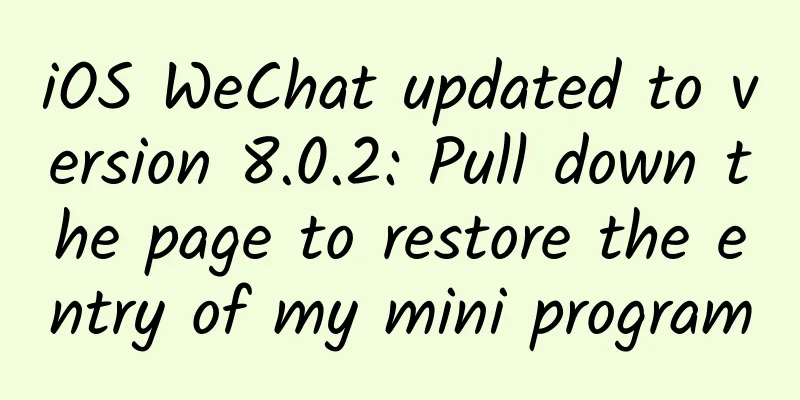Introduction to a new implementation mechanism for keeping mobile APP logged in

|
Features of Mobile App The difference between mobile APP and web login is that App does not require users to log in every time they use it, which increases ease of use. This article introduces the implementation mechanism of App to keep logged in Currently common mechanisms: 1. Use the traditional session mechanism Copy the mechanism of the web page and use the traditional web page's remember login mechanism. After the user enters the correct username and password, a login session is created, and a remember login token is generated and kept on the server side, and sent to the client at the same time. Each time the client starts, a new session is created by recording the login token, and the subsequent use adopts the session mechanism. The server side can use Memcache or Redis to store sessions. Recalling this mechanism, the login token can also be set to a long validity period, such as 30 days. The login token is similar to the Refresh token of Oauth 2.0, and the Session Id in the Session mechanism is similar to the Access token. However, the Session Id in the Session mechanism will be automatically extended when it is used continuously. The advantage of this mechanism is that it makes full use of existing knowledge, is simple and easy to use, and does not have too many new terms and concepts. The disadvantage is that it is not convenient for distributed authentication, and the Session mechanism has a small impact on performance. At the same time, it does not conform to the stateless design spirit of the Restful API. 2. Use a token mechanism with a long validity period After the user logs in correctly, a token with a long validity period (for example, half a year) is generated and saved on the server side. It is also sent to the client. Each request from the client uses this token to verify the identity. Using https transmission encryption, the token will not be obtained in the middle, and the token saved locally cannot be accessed by other programs. For ordinary applications, this solution is also feasible. 3. Use a long-term Refresh Token and a short-term Access Token. For solution 2, if the mobile phone hardware itself has been obtained by hackers, the long-term token may be stolen, which is a potential risk. Taking this into consideration, the Oauth 2.0 standard recommends the use of Refresh Token and Access Token. The validity period of Refresh Token is very long, and the validity period of Access Token is very short. After the user logs in, he will obtain both Refresh Token and Access Token. Normally, he will use Access Token. After the Access Token expires, he will use Refresh Token to obtain a new Access Token. This solution is widely used, including the development of WeChat public platform. But if you think about it carefully, this mechanism is not more secure than Solution 2 (using a long-term token). If a hacker can obtain the Access Token, it is not difficult to obtain the Refresh Token. Using two tokens only adds a little trouble to the hacker. Once a hacker obtains the Refresh Token, he can repeatedly refresh the Access Token. This paper introduces a new mechanism Token exchange mechanism This mechanism uses only a short-term token, such as 1 day. After the user logs in, the token is sent to the client. The user uses this token to authenticate his identity every time he requests. After the token expires, it can be exchanged for a new token. An expired token can only be exchanged for a new token. This is the key. If the token is stolen, the hacker needs to continue to use it and exchange it for a new token. Once the server finds that an old token has been tried to be exchanged for a new token many times, it means there is an abnormality. At this time, the user is forced to log in again. The old token can be exchanged for a new one, not necessarily after it expires. It can be exchanged for a new one when the application is started. This depends on the specific situation. The validity period of this token can be adjusted for different applications. Take the design of China Merchants Bank's app as an example:
To repeat, when designing a security mechanism, you must use https. Without https, most security designs are useless. Appendix: Token Introduction Token is translated into Chinese as token, which is the basis for identifying identity. There are usually two types of tokens: A token without content This token is a unique hash value. To know who owns this token, you need to query a central server. In the central server, user data may be stored in files, databases, or Redis. There is a session id in the cookie of the session mechanism, which is essentially a token of this type. 2. Token containing content This kind of token, like an ID card, contains public user information and uses a signature mechanism to ensure that the token cannot be forged. The most common token of this type is: Json web token (JWT). The advantage of this token is that it does not need to be queried from a central server, which is very useful for distributed systems. For example, after a user logs in, they want to watch a video or download a file. Video and file resources all require user identity verification. Video and file resources are on different servers or even provided by different companies. In this case, JWT with distributed verification is very useful. This kind of distributed verification token usually cannot be cancelled after it is issued, and can only be expired. In order to ensure security, using short-term JWT and replacing the old token with the new one as mentioned above is very effective. The token exchange mechanism mentioned in this article is applicable to both of the above two tokens. A token is a string of information. Even if there are 10,000 copies, there is no difference between them. With the exchange mechanism, the token is a bit like a physical object. If it has been exchanged, it cannot be exchanged again. No matter how many copies there are, only one can be exchanged for a new token. When two people take the same token to exchange for a new one, we cannot judge which one is legal and which one is illegal. Well, both of them log in again to confirm their identities. renew
|
<<: My deep learning development environment: TensorFlow + Docker + PyCharm, etc. What about yours?
>>: GNMT - Google's neural network translation system
Recommend
A complete event operation and promotion!
All operating systems and organizations are only ...
This winter "seasonal fruit" is available online, but many people have a "fear of buying"? Teach you how to choose →
Winter is coming, and it is the best time to eat ...
Information flow advertising: characteristics and trends!
Feed ads are ads that are inserted into the updat...
What is the use of fast charging? The battery is still the obstacle to the development of mobile phone performance
At MWC2017 this year, Meizu brought a new fast-cha...
Summary of the top 10 live broadcasting techniques, interactive techniques in live broadcasting are not boring
I don’t know what to say, I don’t know how to say...
11 ways to improve programmers' work efficiency and keep you away from overtime
Are "hardworking" and "working ove...
Outrageous! These animals use their noses to walk and their ears to fly!
Not long ago, a shocking news came out from the C...
Electric Technology Car News: Great Wall's new model WEY is exposed, positioned as a luxury rival to Guandao
The news about Great Wall's luxury brand WEY ...
Six Chinese automakers have entered the Fortune Global 500, but their combined net profits are not as high as this Japanese automaker
On July 19, 2018 Fortune magazine released the la...
Product operation fission growth model!
Invitation-based rewards is one of the common fis...
World Coffee Day, have you had breakfast today?
Produced by: Science Popularization China Author:...
How to use Zhihu promotion to efficiently attract targeted users?
“Zhihu, share your newly made story with the worl...
Is it the feet's fault if they grow crooked? These three deformities are caused by wearing shoes
"Three-inch golden lotus" is a bad cust...
Real estate companies donated more than 1.1 billion yuan, and 64 real estate companies rushed to Wuhan to fight the epidemic!
In the face of the novel coronavirus pneumonia ep...
Is "old cold legs" caused by not wearing long underwear? The temperature is about to warm up, can we take off the long underwear?
Review expert: Peng Guoqiu, deputy chief physicia...









